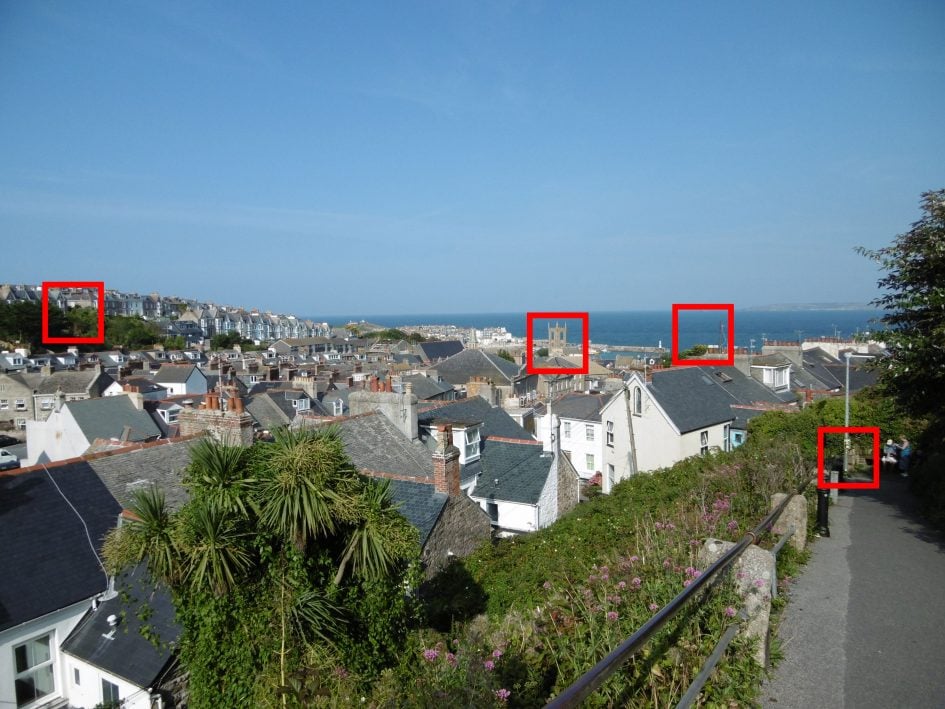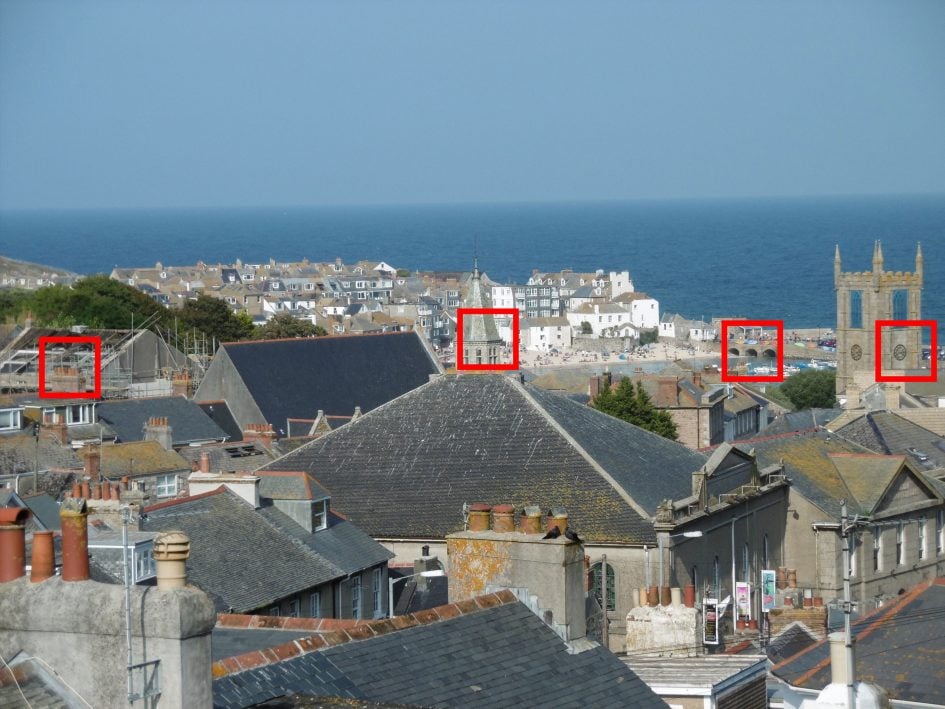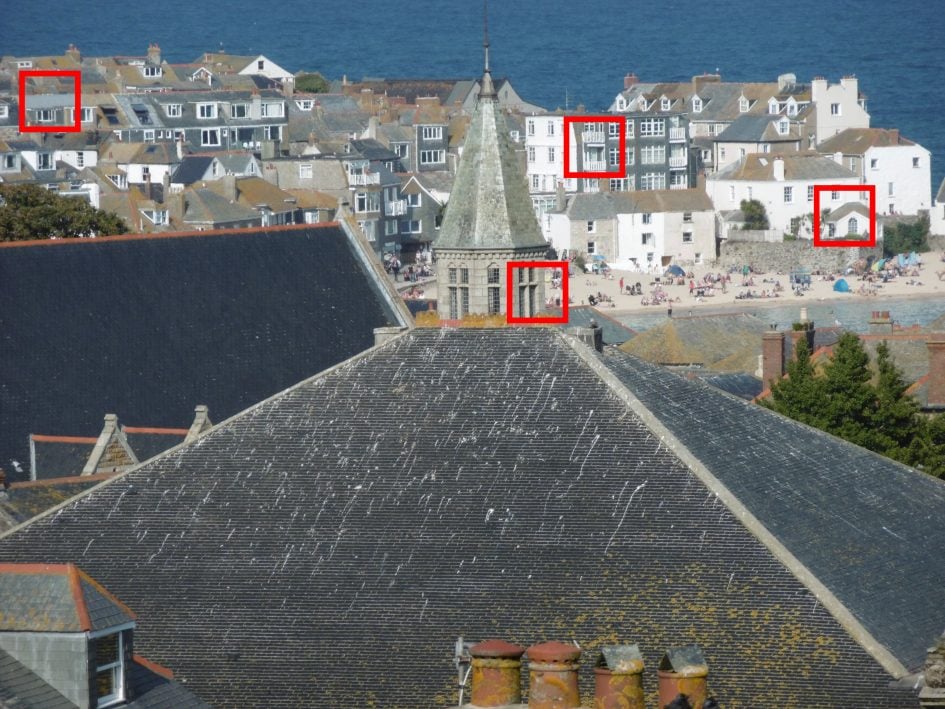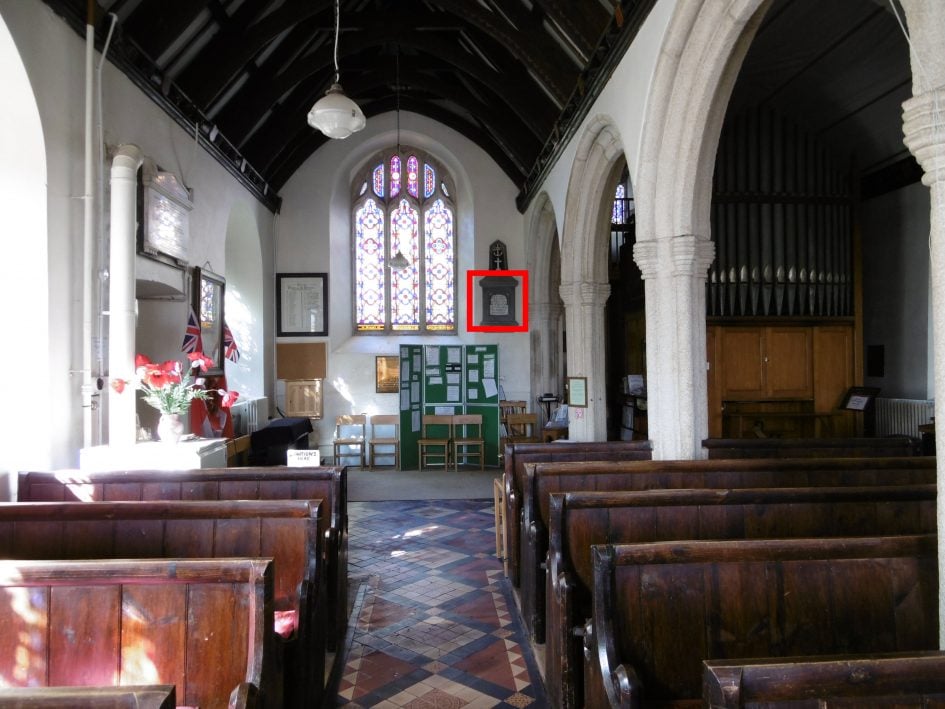Panasonic Lumix SZ8 review
-
-
Written by Ken McMahon
Quality
Lumix SZ8 vs IXUS 265 HS / ELPH 340 HS vs Sony WX350 JPEG

To compare real-life performance I shot this scene with the Panasonic Lumix SZ8, the Canon IXUS 265 HS / ELPH 340 HS, and the Sony Cyber-shot WX350 within a few moments of each other using their best quality JPEG settings.
All three cameras were set to their maximum wide angle setting. At 24mm the Lumix SZ8 goes a tiny bit wider than the IXUS 265 HS / ELPH 340 HS, and the Sony WX350, but in practice the difference is very small and it proved impractical to zoom the SZ8 in by such a small amount. All three cameras were set to Program auto mode.
For this test the cameras were mounted on a tripod and image stabilisation was disabled. The ISO sensitivity was manually set to the lowest available setting and all other settings were left on the defaults.
The image above was taken with the Lumix SZ8. The camera was set to Program Auto (Normal) mode and with the sensitivity manually set to the base 100 ISO setting the SZ8 selected an exposure of 1/250 at f7.8. The IXUS 265 HS / ELPH 340 HS also set to its base 100 ISO sensitivity metered 1/1250 at f3.6 and the Sony WX350, metered 1/1250 at f3,5 and 80 ISO. As usual the crops are taken from the areas marked in red above.
The Lumix SZ8 gets of to a shaky start with a crop from the edge of the frame that looks a little blurry. Things improve by the time we get to the second crop though, with sharper edges and more detail. This crop still looks a tiny bit soft though and the stonework in the church tower and the roof tiles in the foreground lack definition.
The third crop is also good, you can make out the white column of the lighthouse and there’s a hint of detail in the rocks on which it stands, but the Lumix SZ8 falls short of really punchy detail. In the final crop from the right edge of the frame the fuzziness returns, though it’s not nearly as severe as it was in the first crop from the other side.
So an all-round average performance from the Lumix SZ8 with the kind of detail you’d expect from a 16 Megapixel compact sensor, but nothing outstanding. Compared with the crops from the 16 Megapixel IXUS 265 HS / ELPH 340 HS, the Lumix SZ8 crops look soft and lacking in detail. Yes, the IXUS 265 HS / ELPH 340 HS are softer at the edges than the middle, but not to the same degree and the sensor is delivering more to begin with as evidenced by the more detailed second and third crops. While there’s no doubt you need to be looking at 100 percent crops to see it, the IXUS 265 HS / ELPH 340 HS lens and sensor combination produces sharper more detailed images than the Lumix SZ8.
The Sony WX350 has a higher resolution 18.2 Megapixel sensor that prouces a slightly smaller crop area with correspondingly larger detail. and like the IXUS 265 HS / ELPH 340 HS, the Sony sensor is producing more detail and the lens is delivering sharper edges.
Scroll down the page to see how these models compare when zoomed in to 120mm, and 300mm equivalent focal lengths.
Lumix SZ8 vs IXUS 265 HS / ELPH 340 HS vs Sony WX350 Quality

Above: Lumix SZ8 (left) and IXUS 265HS / ELPH 340 HS (centre) at 100 ISO, Sony WX350 (right) at 80 ISO

Above: Lumix SZ8 (left) and IXUS 265HS / ELPH 340 HS (centre) at 100 ISO, Sony WX350 (right) at 80 ISO

Above: Lumix SZ8 (left) and IXUS 265HS / ELPH 340 HS (centre) at 100 ISO, Sony WX350 (right) at 80 ISO

Above: Lumix SZ8 (left) and IXUS 265HS / ELPH 340 HS (centre) at 100 ISO, Sony WX350 (right)at 80 ISO
Lumix SZ8 vs IXUS 265 HS / ELPH 340 HS vs Sony WX350 Quality at approx 120mm

For this next test I zoomed all three cameras in to an equivalent focal length of around 120mm. As before the cameras were set to Program auto mode where they each selected the same f5 aperture.
At this focal length the first crop from the Lumix SZ8 is again comparitively soft and blurry, only this time it looks a little worse than at 24mm. But, the Lumix SZ8 improves significantly in the middle of the frame to produce a much cleaner result, though not quite as detailed as the IXUS 265 HS / ELPH 340 HS.
At this middling focal length, the IXUS 265 HS / ELPH 340 HS performs much the same as it does at its maximum wide angle. There’s a slight degradation in quality at the edge of the frame compared with the middle and its worse on the left hand side than the right. In the middle of the frame there’s a good level of detail and things look nice and sharp though.
The Sony WX350 gets off to a good start at this focal length with a nice sharp crop from the edge of the frame, but there’s a slight clumpiness to the Sony crops which is obscuring the finer detail. Where the IXUS 265 HS / ELPH 340 HS and Sony WX350 were neck and neck at the wide angle setting, here the IXUS 265 HS / ELPH 340 HS definitely has the edge. The Lumix SZ8 comes in third, but, in the middle of the frame at least, it has closed the gap on the other two models.

Above: Lumix SZ8 (left) and IXUS 265HS / ELPH 340 HS (centre) at 100 ISO, Sony WX350 (right) at 80 ISO

Above: Lumix SZ8 (left) and IXUS 265HS / ELPH 340 HS (centre) at 100 ISO, Sony WX350 (right) at 80 ISO

Above: Lumix SZ8 (left) and IXUS 265HS / ELPH 340 HS (centre) at 100 ISO, Sony WX350 (right) at 80 ISO

Above: Lumix SZ8 (left) and IXUS 265HS / ELPH 340 HS (centre) at 100 ISO, Sony WX350 (right)at 80 ISO
Lumix SZ8 vs IXUS 265 HS / ELPH 340 HS vs Sony WX350 Quality at approx 300mm

For this final test I zoomed the Lumix SZ8 in to its maximum 288mm focal length. The IXUS 265 HS / ELPH 340 HS was also zoomed to it’s maximum – a tad longer at at 300mm and the Sony WX350 was zoomed in to match the same angle of view. As before, all three cameras were set to program auto mode and the crops are indicated by the red rectangles.
As a quick glance at these crops will reveal, there’s a loss of finer detail which produces an impressionistic result. This affects all three models to a similar degree and is most likely a result of atmospheric factors as much as lens and sensor performance.
That said, it’s clear that the IXUS 265 HS / ELPH 340 HS produces a cleaner and more detailed result than the Lumix SZ8 which is soft and lacking in contrast. The sony WX350 on the other has has produced quite punchy detailed crops which I think, at least in the centre of the frame, show a little more detail than those from the IXUS 265 HS / ELPH 340 HS. It’s also worth pointing out that the Sony WX350 still has a way to go before reaching its maximum 500mm equivalent focal length.

Above: Lumix SZ8 (left) and IXUS 265HS / ELPH 340 HS (centre) at 100 ISO, Sony WX350 (right) at 80 ISO

Above: Lumix SZ8 (left) and IXUS 265HS / ELPH 340 HS (centre) at 100 ISO, Sony WX350 (right) at 80 ISO

Above: Lumix SZ8 (left) and IXUS 265HS / ELPH 340 HS (centre) at 100 ISO, Sony WX350 (right) at 80 ISO

Above: Lumix SZ8 (left) and IXUS 265HS / ELPH 340 HS (centre) at 100 ISO, Sony WX350 (right)at 80 ISO
Lumix SZ8 vs IXUS 265 HS / ELPH 340 HS vs Sony WX350 Noise

To compare noise levels under real-life conditions, I shot this scene with the Panasonic Lumix SZ8, the Canon IXUS 265 HS / ELPH 340 HS, and the Sony Cyber-shot WX350 within a few moments of each other using their best quality JPEG settings at each of their ISO sensitivity settings.
All three cameras were set to their maximum wide angle setting. At 24mm the Lumix SZ8 goes a tiny bit wider than the IXUS 265 HS / ELPH 340 HS, and the Sony WX350, but in practice the difference is very small and it proved impractical to zoom the SZ8 in by such a small amount. All three cameras were set to Program auto mode. For this test the cameras were mounted on a tripod and image stabilisation was disabled.
The image above was taken with the Lumix SZ8 set to Normal Picture (Program Auto) mode and at its base 100 ISO sensitivity setting it metered a shutter speed of 1/6 at f3.1. Also at 100 ISO the IXUS 265 HS / ELPH 340 HS metered 1/5 at f3.6 and the Sony WX350, at its base 80 ISO sensitivity, metered 1/6 at f3.5.
The Lumix SZ8 has the same 16 Megapixel resolution as the IXUS 265 HS / ELPH 340 HS, but the sensor technologies differ. The SZ8 has a CCD sensor, where the IXUS 265 HS / ELPH 340 HS uses a back-illuminated CMOS sensor for claimed better low-light performance at higher sensitivities. At its base 100 ISO setting the Lumix SZ8 crop looks softer, but no noisier. at 200 ISO there’s a little bit of smeariness creeping in, though, and by 400 ISO there’s visibly less detail. Either the Lumix SZ8 sensor is generating more noise, or the noise supression isn’t so effective at dealing with it, or both. The 800 ISO crop is also worse than the IXUS 265 HS / ELPH 340 HS for the same reason, but by 1600 ISO both sensors are producing so much noise it makes little difference.
The crops from the 18.2 Megapixel Sony WX350 show a smaller area with larger detail. The Sony WX350 crops are smoother and less grainy than those from the Lumix SZ8, it looks like the noise suppression is more aggressive, but there’s still more detail in the WX350 crops than those from the SZ8. Again, unless you’re pixel peeping 100% crops you’re unlikely to notice, particularly at the base ISO sensitivity setting, but from 200 to 800 ISO the WX350 has a definite advantage.
Lastly just to note that the Lumix SZ8 tops out at 1600 ISO where the Sony and Canon go one step beyond to 3200 ISO. The IXUS 265 HS / ELPH 340 HS and Cyber-shot WX350 also have low light composite modes. The IXUS 265 HS / ELPH 340 HS’s Handheld NightScene mode sets the ISO automatically, here I’ve included a crop from the test scene shot where it selected 1250 ISO. The WX350’s Multi Frame Noise Reduction is more versatile, allowing you to manually set the sensitivity, but as the 1600 ISO example shows, it’s not necessarily better in terms of quality.
Now you can check out my Lumix SZ8 sample images to see some more real-life shots in a variety of conditions, or head straight for my verdict.

Above: Sony WX350 (right) at 80 ISO

Above: Lumix SZ8 (left), IXUS 265HS / ELPH 340 HS (centre), and Sony WX350 (right) at 100 ISO

Above: Lumix SZ8 (left), IXUS 265HS / ELPH 340 HS (centre), and Sony WX350 (right) at 200 ISO

Above: Lumix SZ8 (left), IXUS 265HS / ELPH 340 HS (centre), and Sony WX350 (right) at 400 ISO

Above: Lumix SZ8 (left), IXUS 265HS / ELPH 340 HS (centre), and Sony WX350 (right) at 800 ISO

Above: Lumix SZ8 (left), IXUS 265HS / ELPH 340 HS (centre), and Sony WX350 (right) at 1600 ISO

Above: Lumix SZ8 (left), IXUS 265HS / ELPH 340 HS (centre), and Sony WX350 (right) at 3200 ISO

Above: IXUS 265HS / ELPH 340 HS Handheld Nightscene 1250 ISO (centre), and Sony WX350 MFNR 1600 ISO (right)




